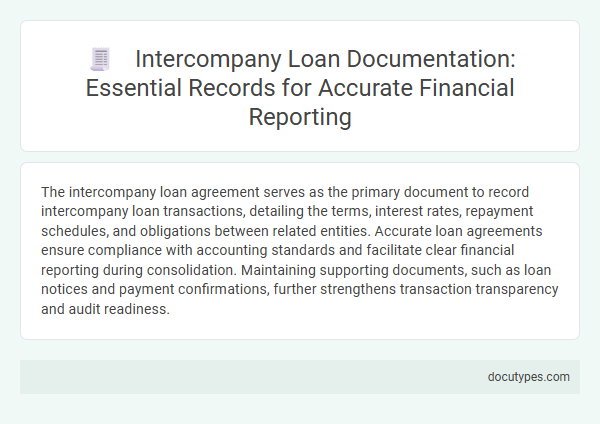The intercompany loan agreement serves as the primary document to record intercompany loan transactions, detailing the terms, interest rates, repayment schedules, and obligations between related entities. Accurate loan agreements ensure compliance with accounting standards and facilitate clear financial reporting during consolidation. Maintaining supporting documents, such as loan notices and payment confirmations, further strengthens transaction transparency and audit readiness.
Introduction to Intercompany Loan Documentation
Intercompany loan transactions require specific documentation to ensure clarity and compliance between related business entities. Proper documentation helps in tracking loan terms, interest rates, repayment schedules, and regulatory adherence.
You need to prepare intercompany loan agreements that outline the responsibilities of each party involved. These documents serve as a formal record to avoid disputes and support financial audits and tax filings.
Importance of Accurate Intercompany Loan Records
Accurate documentation is essential to record intercompany loan transactions, typically requiring a formal loan agreement that outlines the terms, interest rates, and repayment schedule. Maintaining precise records ensures compliance with accounting standards and regulatory requirements, reducing the risk of disputes between affiliated companies. Your financial reports benefit from clear intercompany loan documentation, enhancing transparency and facilitating audit processes.
Key Components of Intercompany Loan Agreements
Which document is essential to accurately record intercompany loan transactions? The intercompany loan agreement serves as the primary document, establishing the terms and conditions of the loan between related entities. This agreement ensures transparency and compliance with accounting standards and corporate governance.
What are the key components of an intercompany loan agreement? It typically includes the principal amount, interest rate, repayment schedule, and maturity date. Additional components cover covenants, default provisions, and governing law to safeguard both parties' interests.
Supporting Documents for Intercompany Loans
Recording intercompany loan transactions requires specific supporting documents to ensure clear and accurate financial records. Proper documentation helps maintain transparency and compliance within your organization.
- Loan Agreement - Defines the terms, interest rate, repayment schedule, and parties involved in the intercompany loan.
- Board Resolutions - Authorization by both lending and borrowing entities to approve and record the intercompany loan.
- Payment Records - Proof of loan disbursements and repayments to track cash flows and loan balances accurately.
Keeping these supporting documents organized is essential for auditing and regulatory purposes.
Regulatory Compliance and Intercompany Loans
Accurate documentation of intercompany loan transactions is essential for ensuring regulatory compliance and maintaining transparent financial records. Properly recorded documents help prevent legal issues and support audit processes within multinational corporations.
- Loan Agreement - This document outlines the terms, interest rates, repayment schedules, and obligations between related parties involved in the intercompany loan.
- Intercompany Loan Register - A detailed ledger that records all intercompany loan transactions, ensuring traceability and accuracy in financial reporting.
- Regulatory Filings - Required documents submitted to tax authorities or regulators to demonstrate compliance with transfer pricing rules and local lending laws.
Best Practices for Intercompany Loan Documentation
Recording intercompany loan transactions requires precise documentation to ensure transparency and compliance with financial regulations. The primary document needed is the Intercompany Loan Agreement, which clearly outlines terms such as loan amount, interest rate, repayment schedule, and covenants. Maintaining thorough records helps your finance team manage risk, facilitate audits, and uphold best practices in intercompany lending.
Common Pitfalls in Recording Intercompany Loans
Recording intercompany loan transactions requires precise documentation to ensure accuracy and compliance. The primary document needed is the Intercompany Loan Agreement, which outlines the terms, interest rates, and repayment schedules between the entities involved.
Common pitfalls in recording intercompany loans include neglecting to formalize the agreement, leading to disputes or audit issues. Another frequent error is failing to properly document interest accruals, which can distort financial statements. You must maintain consistent records and ensure transparent communication between the parties to avoid these issues.
Audit Preparation: Intercompany Loan Documentation Checklist
Accurate documentation of intercompany loan transactions is essential for audit readiness and regulatory compliance. Maintaining a comprehensive set of financial documents ensures transparency and facilitates efficient audit processes.
- Loan Agreement - Details the terms, conditions, and repayment schedule agreed between the lending and borrowing entities.
- Board Resolutions - Authorizes the intercompany loan and records official approval from relevant corporate bodies.
- Repayment Records - Tracks payments made, interest accrued, and outstanding balances to verify accuracy during audits.
Impact of Intercompany Loan Documentation on Financial Reporting
| Document Type | Purpose | Impact on Financial Reporting |
|---|---|---|
| Intercompany Loan Agreement | Formalizes the loan terms between related entities including principal amount, interest rate, repayment schedule, and covenants. | Ensures accurate recognition of loan balances and interest expense, supporting transparency and compliance with accounting standards such as IFRS and GAAP. |
| Promissory Note | Serves as a written promise to pay back the loan, outlining repayment obligations. | Provides evidence of the debt, essential for audit trail and verification of intercompany liabilities in financial statements. |
| Board Resolutions or Approval Documents | Authorizes the intercompany loan transaction and ensures proper governance and compliance. | Supports the validity of the transaction, crucial for accurate disclosure and risk assessment in consolidated financial reporting. |
| Loan Repayment Schedules | Details the timing and amounts of repayments agreed upon by entities. | Facilitates proper matching of expenses and liabilities over reporting periods, impacting cash flow statements and balance sheets. |
| Interest Calculation Reports | Details the interest accrued on the intercompany loan based on agreed rates. | Ensures accurate interest income and expense recording, affecting net profit and tax computations. |
Your intercompany loan documentation directly influences the reliability of financial reports, affecting consolidation, eliminations, and regulatory compliance.
Which Document Is Needed to Record Intercompany Loan Transactions? Infographic

